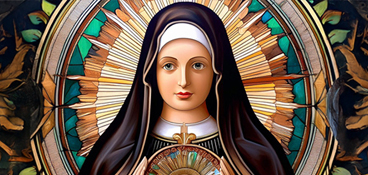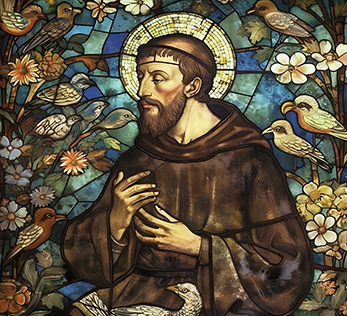St. Clare of Assisi
St. Clare is the patron saint of eye disease, goldsmiths, and laundry
St. Clare’s feast day is August 11

No one in the world understood St. Francis so well or upheld his ideals so faithfully as did St. Clare. A contemporary of Francis, Clare wanted to share Francis’ choice of life and his ideal of evangelical poverty.
The story of St. Clare of Assisi
At age 18, Clare secretly left home for a midnight meeting at the Portiuncula Church with St. Francis and some of the brothers. St. Francis cut off her hair, received her religious promises, gave her the sackcloth habit and cord of his order, and handed her over to some Benedictine nuns until he could found the convent at San Damiano. Soon, Clare’s 15-year-old sister, Agnes, stole away and joined her. Eventually, their mother and another sister also put themselves under Clare’s rule.
The beginnings of the Poor Clares
These were the beginnings of the Poor Ladies, which would later become the Order of Poor Clares. Clare wrote a very strict rule for her nuns. They observed a continual fast, ate no meat, and spoke only when necessary. In addition, they wore nothing on their feet, observed the night-and-day rhythm of the Church’s Liturgy of the Hours, and lived within the enclosure. They did not engage in active apostolate like the brothers, but rather made their contribution through penance. They remain the most penitential of the large orders of nuns.
What makes St. Clare special
In her rule, St. Clare called herself the “little plant” of St. Francis. Her spirit is often considered the feminine embodiment of St. Francis’ spirit: love of God and of all creation, devotion to the humanity of Christ and especially His passion, humility, detachment, simplicity, and enthusiasm—all combining to make her more, rather than less, human.
In the matter of poverty, Clare won over three of the great popes of the century. When Gregory IX offered to dispense her from the vow of strict poverty she replied, “Holy Father, absolve me from my sins but not from the obligation of following our Lord.”
Clare is the patron saint of eye disease, goldsmiths, laundry, television, bicycle messengers, good weather, needleworkers, remote viewing, and extrasensory perception.
Important dates for St. Clare
Clare died in 1253 at the age of 60 and was canonized two years later. St. Clare’s Feast Day is August 11.
How to pray to St. Clare
O Blessed Saint Clare,
Your life shines like a beacon and casts its light down the ages of the church to guide the way to Christ. Look with compassion on the poor and humble who call on you for help.
As you bow before your Eucharistic Lord in Heaven, speak to him of my afflicted body and broken spirit. Ask him to heal me and to wash away my sins.
Amen.
For daily inspiration from the Saints, follow our Facebook page.
Make an offering
with a prayer intention
to St. Clare
No one in the world understood St. Francis so well or upheld his ideals so faithfully as did St. Clare. A contemporary of Francis, Clare wanted to share Francis’ choice of life and his ideal of evangelical poverty.
The story of St. Clare of Assisi
At age 18, Clare secretly left home for a midnight meeting at the Portiuncula Church with St. Francis and some of the brothers. St. Francis cut off her hair, received her religious promises, gave her the sackcloth habit and cord of his order, and handed her over to some Benedictine nuns until he could found the convent at San Damiano. Soon, Clare’s 15-year-old sister, Agnes, stole away and joined her. Eventually, their mother and another sister also put themselves under Clare’s rule.
The beginnings of the Poor Clares
These were the beginnings of the Poor Ladies, which would later become the Order of Poor Clares. Clare wrote a very strict rule for her nuns. They observed a continual fast, ate no meat, and spoke only when necessary. In addition, they wore nothing on their feet, observed the night-and-day rhythm of the Church’s Liturgy of the Hours, and lived within the enclosure. They did not engage in active apostolate like the brothers, but rather made their contribution through penance. They remain the most penitential of the large orders of nuns.
What makes St. Clare special
In her rule, St. Clare called herself the “little plant” of St. Francis. Her spirit is often considered the feminine embodiment of St. Francis’ spirit: love of God and of all creation, devotion to the humanity of Christ and especially His passion, humility, detachment, simplicity, and enthusiasm—all combining to make her more, rather than less, human.
In the matter of poverty, Clare won over three of the great popes of the century. When Gregory IX offered to dispense her from the vow of strict poverty she replied, “Holy Father, absolve me from my sins but not from the obligation of following our Lord.”
Clare is the patron saint of eye disease, goldsmiths, laundry, television, bicycle messengers, good weather, needleworkers, remote viewing, and extrasensory perception.
Important dates for St. Clare
Clare died in 1253 at the age of 60 and was canonized two years later. St. Clare’s Feast Day is August 11.
How to pray to St. Clare
O Blessed Saint Clare,
Your life shines like a beacon and casts its light down the ages of the church to guide the way to Christ. Look with compassion on the poor and humble who call on you for help.
As you bow before your Eucharistic Lord in Heaven, speak to him of my afflicted body and broken spirit. Ask him to heal me and to wash away my sins.
Amen.
For daily inspiration from the Saints, follow our Facebook page.










